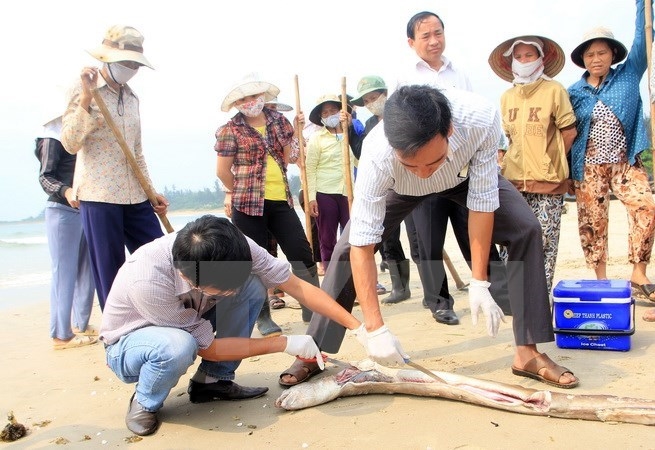 Op-Ed
Op-Ed

The massive fish death along the central coastal areas of Việt Nam over the last few weeks raises many questions about the responsibility of the media, the reaction of the public, the lack of timely response from the Government and how Việt Nam is to balance its economic development with protecting the environment.
 |
| Authorities collects fish samples for test in the central region. — VNA/VNS Photo Trần Tĩnh |
By Thu Vân
Over the past three weeks, the incidents of massive fish die-off along Việt Nam’s central coastal provinces, and the reactions from concerned parties have been pretty upsetting to me.
Of course, I have to say that what is happening to nature and its consequences for local residents whose livelihoods depend so much on the sea is a disaster. But as a reporter, I tend to first take a look at how the incident has been reported to readers.
What I witnessed was a wave of anger (which is understandable), and then, something almost like an accusation of the Taiwanese conglomerate Formosa for causing the incident, even before any official scientific proof is provided.
Local media coverage has been making guesses about the possibility of a 1.5km wastewater pipeline that runs directly from Formosa’s multibillion-dollar steel plant in Hà Tĩnh Province discharging untreated wastewater into the ocean.
Some reporters tried diving under the water to take a look at the wastewater pipeline. Others conducted tests to show people that fish died some minutes after being put into water taken from the sea near the factory.
Stories on Facebook were shared, liked and commented on with rapid speed. Everybody is talking about it, blaming Formosa for it, and asking the company to leave Viet Nam. It also seems to me that everybody has decided that Formosa is the culprit in this case.
This reminds me of my education in journalism. I remember well the words of one of my professors who said, “The true calling of the job is to simply to inform without bias or favour.” It is a constant search to arrange the varied aspects of an argument and present them, not according to your own judgment of right or wrong, but for the consideration of others.
Finding the cause of the massive fish death and imposing strict punishments if violations of environmental regulations are discovered is definitely important. It must be done. But it needs to be done in a professional way, with the participation of those specialised in that field.
In a meeting yesterday between relevant ministries and scientists, which was the first meeting about the case between central and local managing bodies and scientists, the Ministry of Natural Resources and Environment told the media that they had identified two possibile groups of causes for the massive death of fish recently. The first potential cause is the impact of poisonous chemical substances discharged by humans from the mainland or in the sea. The second possible cause is an abnormal natural phenomenon combined with human impacts, resulting in a phenomenon called "water bloom" or "red tie". They also said that to date, there’s no evidence to prove that there’s a connection between Formosa and other factories and the massive fish death.
That might be a disappointment for those who have been waiting for the promised conclusion. But I agree that before we can come to a conclusion, we need to know exactly what poisonous heavy metals, if any, caused the fish to die? Where did these factors come from? Who is responsible for it? All these questions need to be answered with scientific tests and evidence, not guesses and suspicion. In the meantime, what reporters can do is report in a balanced and unbiased manner, and not act as opinion makers.
What else I see is that while the cause still remains unknown, the spreading of such suspicions has already had sad consequences. Fishermen are not going offshore to fish during this time because no one will buy their fish, and tourists have been canceling their trips to these provinces. You can all imagine how difficult it is for them now. Now what caused this, if not for the unproven guesses that the mass media has been spreading over the past weeks?
A friend of mine, a Vietnamese scientist who is living in the US, said while warnings to people are essential, only specific data can be used as evidence.
Government reaction
What upsets me more about this is the reaction from the Government. In fact, we didn’t see any reaction at all in the first two weeks after information about the massive fish death went public.
As the fish started dying, the Government had no reaction, and thus the mass media has been “guiding” public opinion. However, fish have been dying in massive numbers in many other countries since March this year. Sixty-five tonnes of fish have died in the waters of Kampong Thom, Cambodia, 40 tonnes of fish have died in a lake in Nalgonda district, India, 70 tonnes of dead fish were found in a river in Magdalena Department, Colombia, 4,000 tonnes of sardines washed up in Araucania, Chile, and the list goes on. These countries have been working to find out the cause, as well.
When the fish died, the local authorities did not act promptly enough to clean up the beaches. It was only until April 24 that the Government started to call on scientists to work on the case, and called for support for affected local residents. Too much time has been wasted.
Only until yesterday, Thừa Thiên-Huế Province became the first to announce the cause of mass fish deaths in its area - but still not the specific one. Local authorities blamed a strong toxic substance in water.
Deputy director of Thừa Thiên-Huế Province’s Department of Natural Resources and Environment , Nguyễn Hữu Quyết, said at the meeting that the water samples taken from local sea showed that the level of Ammonium and Chromium all excess legal levels.
This is an incident that should ring alarm bells for both the Vietnamese Government and the people in other aspects.
Throughout the proceedings of this case, we realised that the Government has a rather loose management of wastewater treatment. Reports showed that while Formosa did have a wastewater treatment system, local authorities had no way of ensuring the system was working properly. All we have is a commitment to do good for the environment! As much as I protest the environmental problems that multinational companies like Formosa cause their host countries, I truly hope they have been acting according with their commitments - because if not, the consequences might be terrible and mind-blowing.
We also need to take a look at the capability of our domestic scientific institutions. Why does it take so long for results to become available? Why don’t we have an independent institution that can act promptly without waiting for permission or for proof that they have the right idea? After all, what we all need is to find the cause of the fish death so that we can figure out our next steps – not simply the wish to punish someone for our own satisfaction.
After all, if Việt Nam wants to grow green, its leaders really need to sit back and consider what Chou Chun-fan, Formosa Hà Tĩnh’s external relations manager, told the State-run VTC14 television channel: “You cannot have both. You need to choose whether to catch fish and shrimp or to build a state-of-the-art steel mill.”
After all, we shouldn’t have to wait for such a massive fish die-off to raise the problems of environmental degradation. We should have been tackling it long before. But it’s better late than never. Balancing between economic development and guarding the environment has never been easy – our leaders need to choose. They can choose to be brave enough to address an arising problem before it becomes a true crisis.
And the people also need to make a choice today. Have you been teaching your children to use reusable bags and love nature? Have you been switching off the lights as you leave a room? Have you been classifying your waste? It all starts with the small stuff. — VNS